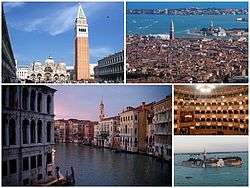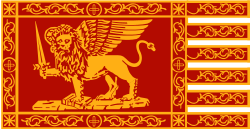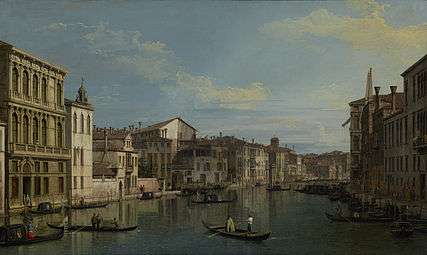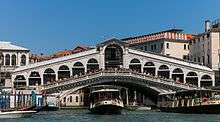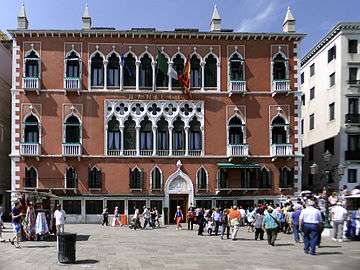Venice
| Venice Venezia | |||
|---|---|---|---|
| Comune | |||
| Comune di Venezia | |||
|
A collage of Venice: at the top left is the Piazza San Marco, followed by a view of the city, then the Grand Canal, and (smaller) the interior of La Fenice and, finally, the Island of San Giorgio Maggiore. | |||
| |||
 Venice Location of Venice in Italy | |||
| Coordinates: 45°26′15″N 12°20′9″E / 45.43750°N 12.33583°ECoordinates: 45°26′15″N 12°20′9″E / 45.43750°N 12.33583°E | |||
| Country | Italy | ||
| Region | Veneto | ||
| Province / Metropolitan city | Metropolitan City of Venice | ||
| Frazioni | Chirignago, Favaro Veneto, Mestre, Marghera, Murano, Burano, Giudecca, Lido, Zelarino | ||
| Government | |||
| • Mayor | Luigi Brugnaro (I) | ||
| Area | |||
| • Total | 414.57 km2 (160.07 sq mi) | ||
| Elevation | 1 m (3 ft) | ||
| Population (2014) | |||
| • Total | 264,579 | ||
| • Density | 640/km2 (1,700/sq mi) | ||
| Demonym(s) | Venetian | ||
| Time zone | CET (UTC+1) | ||
| • Summer (DST) | CEST (UTC+2) | ||
| Postal code | 30100 | ||
| Dialing code | 041 | ||
| Patron saint | St. Mark the Evangelist | ||
| Saint day | 25 April | ||
| Website | Official website | ||
| Venice and its Lagoon | |
|---|---|
| Name as inscribed on the World Heritage List | |
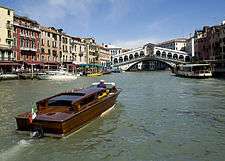 | |
| Type | Cultural |
| Criteria | i, ii, iii, iv, v, vi |
| Reference | 394 |
| UNESCO region | Europe and North America |
| Inscription history | |
| Inscription | 1987 (11th Session) |
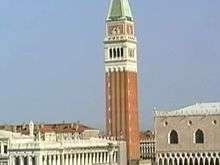
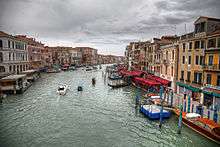
_2.jpg)
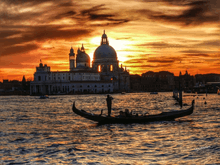
Venice (English /ˈvɛnɪs/ VEN-iss; Italian: Venezia [veˈnɛttsja]; Venetian: Venesia) is a city in northeastern Italy and the capital of the Veneto region. It is situated across a group of 117 small islands that are separated by canals and linked by bridges.[1] These are located in the shallow Venetian Lagoon, an enclosed bay that lies between the mouths of the Po and the Piave Rivers. Parts of Venice are renowned for the beauty of their settings, their architecture, and artwork.[1] The lagoon and a part of the city are listed as a World Heritage Site.[1]
In 2014, 264,579 people resided in Comune di Venezia, of whom around 55,000 live in the historic city of Venice (Centro storico). Together with Padua and Treviso, the city is included in the Padua-Treviso-Venice Metropolitan Area (PATREVE), with a total population of 2.6 million. PATREVE is only a statistical metropolitan area without any degree of autonomy.[2]
The name is derived from the ancient Veneti people who inhabited the region by the 10th century BC.[3][4] The city was historically the capital of the Republic of Venice. Venice has been known as the "La Dominante," "Serenissima," "Queen of the Adriatic," "City of Water," "City of Masks," "City of Bridges," "The Floating City," and "City of Canals."
The Republic of Venice was a major financial and maritime power during the Middle Ages and Renaissance, and a staging area for the Crusades and the Battle of Lepanto, as well as a very important center of commerce (especially silk, grain, and spice) and art in the 13th century up to the end of the 17th century. The City State of Venice is considered to have been the first real international financial center which gradually emerged from the 9th century to its peak in the 14th century.[5] This made Venice a wealthy city throughout most of its history.[6]
It is also known for its several important artistic movements, especially the Renaissance period. After the Napoleonic Wars and the Congress of Vienna, the Republic was annexed by the Austrian Empire, until it became part of the Kingdom of Italy in 1866, following a referendum held as a result of the Third Italian War of Independence. Venice has played an important role in the history of symphonic and operatic music, and it is the birthplace of Antonio Vivaldi.[7]
Etymology
The name of the city, deriving from Latin forms Venetia and Venetiae, is most likely taken from "Venetia et Histria", the Roman name of Regio X of Roman Italy, but applied to the coastal part of the region that remained under Roman Empire outside of Gothic, Lombard, and Frankish control. The name Venetia, however, derives from the Roman name for the people known as the Veneti, and called by the Greeks Eneti (Ἐνετοί). The meaning of the word is uncertain, although there are other Indo-European tribes with similar-sounding names, such as the Celtic Veneti, Baltic Veneti, and the Slavic Wends. Linguists suggest that the name is based on an Indo-European root *wen ("love"), so that *wenetoi would mean "beloved", "lovable", or "friendly". A connection with the Latin word venetus, meaning the color 'sea-blue', is also possible. Supposed connections of Venetia with the Latin verb venire (to come), such as Marin Sanudo's veni etiam ("Yet, I have come!"), the supposed cry of the first refugees to the Venetian lagoon from the mainland, or even with venia ("forgiveness") are fanciful. The alternative obsolete form is Vinegia [viˈnɛːdʒa];[8] (Venetian: Venèxia [veˈnɛzja]; Latin: Venetiae; Slovene: Benetke).
History
Origins
Although no surviving historical records deal directly with the founding of Venice,[9] tradition and the available evidence have led several historians to agree that the original population of Venice consisted of refugees from Roman cities near Venice such as Padua, Aquileia, Treviso, Altino and Concordia (modern Portogruaro) and from the undefended countryside, who were fleeing successive waves of Germanic and Hun invasions.[10] Some late Roman sources reveal the existence of fishermen on the islands in the original marshy lagoons. They were referred to as incolae lacunae ("lagoon dwellers"). The traditional founding is identified with the dedication of the first church, that of San Giacomo on the islet of Rialto (Rivoalto, "High Shore") — said to have taken place at the stroke of noon on 25 March 421 (the Feast of the Annunciation).[11][12]
Beginning as early as AD 166 to 168, the Quadi and Marcomanni destroyed the main center in the area, the current Oderzo. The Roman defences were again overthrown in the early 5th century by the Visigoths and, some 50 years later, by the Huns led by Attila. The last and most enduring immigration into the north of the Italian peninsula, that of the Lombards in 568, left the Eastern Roman Empire a small strip of coast in the current Veneto, including Venice. The Roman/Byzantine territory was organized as the Exarchate of Ravenna, administered from that ancient port and overseen by a viceroy (the Exarch) appointed by the Emperor in Constantinople, but Ravenna and Venice were connected only by sea routes; and with the Venetians' isolated position came increasing autonomy. New ports were built, including those at Malamocco and Torcello in the Venetian lagoon. The tribuni maiores, the earliest central standing governing committee of the islands in the Lagoon, dated from c. 568.[13]
The traditional first doge of Venice, Paolo Lucio Anafesto, was actually Exarch Paul, and his successor, Marcello Tegalliano, was Paul's magister militum (General: literally, "Master of Soldiers"). In 726 the soldiers and citizens of the Exarchate rose in a rebellion over the iconoclastic controversy at the urging of Pope Gregory II. The Exarch was murdered and many officials put to flight in the chaos. At about this time, the people of the lagoon elected their own leader for the first time, although the relationship of this to the uprisings is not clear. Ursus was the first of 117 "doges" (doge is the Venetian dialect development of the Latin dux ("leader"); the corresponding word in English is duke, in standard Italian duce.) Whatever his original views, Ursus supported Emperor Leo III's successful military expedition to recover Ravenna, sending both men and ships. In recognition of this, Venice was "granted numerous privileges and concessions" and Ursus, who had personally taken the field, was confirmed by Leo as dux[14] and given the added title of hypatus (Greek for "Consul".)[15]
In 751 the Lombard King Aistulf conquered most of the Exarchate of Ravenna, leaving Venice a lonely and increasingly autonomous Byzantine outpost. During this period, the seat of the local Byzantine governor (the "duke/dux", later "doge"), was situated in Malamocco. Settlement on the islands in the lagoon probably increased with the Lombard conquest of other Byzantine territories, as refugees sought asylum there. In 775/6 the episcopal seat of Olivolo (San Pietro di Castello; Helipolis) was created. During the reign of duke Agnello Particiaco (811–827) the ducal seat moved from Malamocco to the highly protected Rialto, the current location of Venice. The monastery of St Zachary and the first ducal palace and basilica of St. Mark, as well as a walled defense (civitatis murus) between Olivolo and Rialto, were subsequently built here.
Charlemagne sought to subdue the city to his own rule. He ordered the Pope to expel the Venetians from the Pentapolis along the Adriatic coast,[16] and Charlemagne's own son Pepin of Italy, king of the Lombards under the authority of his father, embarked on a siege of Venice itself. This, however, proved a costly failure. The siege lasted six months, with Pepin's army ravaged by the diseases of the local swamps and eventually forced to withdraw (810). A few months later, Pepin himself died, apparently as a result of a disease contracted there. In the aftermath, an agreement between Charlemagne and the Byzantine Emperor Nicephorus in 814 recognized Venice as Byzantine territory and granted the city trading rights along the Adriatic coast.
In 828 the new city's prestige increased with the acquisition of the claimed relics of St Mark the Evangelist from Alexandria, which were placed in the new basilica. (Winged lions, visible throughout Venice, symbolise St Mark.) The patriarchal seat also moved to Rialto. As the community continued to develop and as Byzantine power waned, its autonomy grew, leading to eventual independence.[17]
Expansion
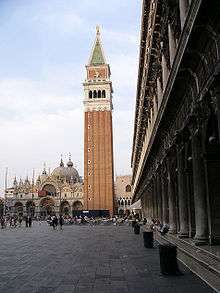
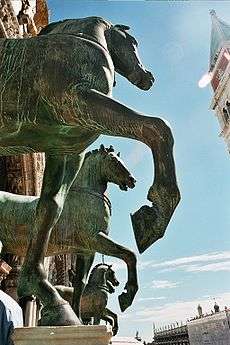
From the 9th to the 12th century, Venice developed into a city state (an Italian thalassocracy or Repubblica Marinara: the other three of these were Genoa, Pisa, and Amalfi). Its strategic position at the head of the Adriatic made Venetian naval and commercial power almost invulnerable. With the elimination of pirates along the Dalmatian coast, the city became a flourishing trade center between Western Europe and the rest of the world (especially the Byzantine Empire and Asia) with a naval power protecting sea routes from Islamic piracy.[18]
The Republic of Venice seized a number of places on the eastern shores of the Adriatic before 1200, mostly for commercial reasons, because pirates based there were a menace to trade. The Doge already carried the titles of Duke of Dalmatia and Duke of Istria. Later mainland possessions, which extended across Lake Garda as far west as the Adda River, were known as the "Terraferma", and were acquired partly as a buffer against belligerent neighbours, partly to guarantee Alpine trade routes, and partly to ensure the supply of mainland wheat, on which the city depended. In building its maritime commercial empire, the Republic dominated the trade in salt,[19] acquired control of most of the islands in the Aegean, including Cyprus and Crete, and became a major power-broker in the Near East. By the standards of the time, Venice's stewardship of its mainland territories was relatively enlightened and the citizens of such towns as Bergamo, Brescia and Verona rallied to the defence of Venetian sovereignty when it was threatened by invaders.
Venice remained closely associated with Constantinople, being twice granted trading privileges in the Eastern Roman Empire, through the so-called Golden Bulls or "chrysobulls" in return for aiding the Eastern Empire to resist Norman and Turkish incursions. In the first chrysobull, Venice acknowledged its homage to the Empire; but not in the second, reflecting the decline of Byzantium and the rise of Venice's power.[20][21]
Venice became an imperial power following the Fourth Crusade, which, having veered off course, culminated in 1204 by capturing and sacking Constantinople and establishing the Latin Empire. As a result of this conquest, considerable Byzantine plunder was brought back to Venice. This plunder included the gilt bronze horses from the Hippodrome of Constantinople, which were originally placed above the entrance to the cathedral of Venice, St Mark's Basilica, although the originals have been replaced with replicas and are now stored within the basilica. After the fall of Constantinople, the former Roman Empire was partitioned among the Latin crusaders and the Venetians. Venice subsequently carved out a sphere of influence in the Mediterranean known as the Duchy of the Archipelago, and captured Crete.[22]
The seizure of Constantinople proved as decisive a factor in ending the Byzantine Empire as the loss of the Anatolian themes after Manzikert. Although the Byzantines recovered control of the ravaged city a half-century later, the Byzantine Empire was terminally weakened, and existed as a ghost of its old self until Sultan Mehmet The Conqueror took the city in 1453.

Situated on the Adriatic Sea, Venice always traded extensively with the Byzantine Empire and the Muslim world. By the late 13th century, Venice was the most prosperous city in all of Europe. At the peak of its power and wealth, it had 36,000 sailors operating 3,300 ships, dominating Mediterranean commerce. Venice's leading families vied with each other to build the grandest palaces and support the work of the greatest and most talented artists. The city was governed by the Great Council, which was made up of members of the noble families of Venice. The Great Council appointed all public officials and elected a Senate of 200 to 300 individuals. Since this group was too large for efficient administration, a Council of Ten (also called the Ducal Council or the Signoria), controlled much of the administration of the city. One member of the great council was elected "Doge", or duke, the chief executive, who usually held the title until his death; although several Doges were forced by pressure from their oligarchical peers to resign and retire into monastic seclusion when they were felt to have been discredited by political failure.
The Venetian government structure was similar in some ways to the republican system of ancient Rome, with an elected chief executive (the Doge), a senate-like assembly of nobles, and a mass of citizens with limited political power, who originally had the power to grant or withhold their approval of each newly elected Doge. Church and various private properties were tied to military service, although there was no knight tenure within the city itself. The Cavalieri di San Marco was the only order of chivalry ever instituted in Venice, and no citizen could accept or join a foreign order without the government's consent. Venice remained a republic throughout its independent period, and politics and the military were kept separate, except when on occasion the Doge personally headed the military. War was regarded as a continuation of commerce by other means (hence, the city's early production of large numbers of mercenaries for service elsewhere, and later its reliance on foreign mercenaries when the ruling class was preoccupied with commerce).


Although the people of Venice generally remained orthodox Roman Catholics, the state of Venice was notable for its freedom from religious fanaticism and executed nobody for religious heresy during the Counter-Reformation. This apparent lack of zeal contributed to Venice's frequent conflicts with the Papacy. In this context, the writings of the Anglican divine William Bedell are particularly illuminating. Venice was threatened with the interdict on a number of occasions, and twice suffered its imposition. The second, most noted, occasion was in 1606, by order of Pope Paul V.
Venetian ambassadors sent home still-extant secret reports of the politics and rumours of European courts, providing fascinating information to modern historians.
The newly invented German printing press spread rapidly throughout Europe in the 15th century, and Venice was quick to adopt it. By 1482, Venice was the printing capital of the world, and the leading printer was Aldus Manutius, who invented paperback books that could be carried in a saddlebag. His Aldine Editions included translations of nearly all the known Greek manuscripts of the era.[23]
Decline
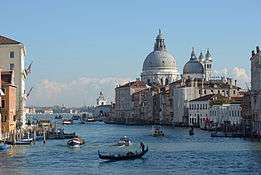
Venice's long decline started in the 15th century, when it first made an unsuccessful attempt to hold Thessalonica against the Ottomans (1423–1430). It also sent ships to help defend Constantinople against the besieging Turks (1453). After Constantinople fell to Sultan Mehmet II, he declared war on Venice. The war lasted thirty years and cost Venice much of its eastern Mediterranean possessions. Next, Christopher Columbus discovered the New World in 1492. Then Vasco da Gama of Portugal found a sea route to India by rounding the Cape of Good Hope during his first voyage of 1497–99, destroying Venice's land route monopoly. France, England and the Dutch Republic followed. Venice's oared galleys were at a disadvantage when it came to traversing the great oceans, and therefore Venice was left behind in the race for colonies.
The Black Death devastated Venice in 1348 and once again between 1575 and 1577.[24] In three years, the plague killed some 50,000 people.[25] In 1630, the Italian plague of 1629–31 killed a third of Venice's 150,000 citizens.[26] Venice began to lose its position as a center of international trade during the later part of the Renaissance as Portugal became Europe's principal intermediary in the trade with the East, striking at the very foundation of Venice's great wealth; while France and Spain fought for hegemony over Italy in the Italian Wars, marginalising its political influence. However, the Venetian empire was a major exporter of agricultural products, and until the mid-18th century, a significant manufacturing center.
Modern age

During the 18th century, Venice became perhaps the most elegant and refined city in Europe, greatly influencing art, architecture and literature. But the Republic lost its independence when Napoleon Bonaparte conquered Venice on 12 May 1797 during the First Coalition. Napoleon was seen as something of a liberator by the city's Jewish population, although it can be argued they had lived with fewer restrictions in Venice. He removed the gates of the Ghetto and ended the restrictions on when and where Jews could live and travel in the city.
Venice became Austrian territory when Napoleon signed the Treaty of Campo Formio on 12 October 1797. The Austrians took control of the city on 18 January 1798. But Venice was taken from Austria by the Treaty of Pressburg in 1805 and became part of Napoleon's Kingdom of Italy; however it was returned to Austria following Napoleon's defeat in 1814, when it became part of the Austrian-held Kingdom of Lombardy-Venetia. In 1848–9, a revolt briefly re-established the Venetian Republic under Daniele Manin. In 1866, after the Third Italian War of Independence, Venice, along with the rest of the Veneto, became part of the newly created Kingdom of Italy.
During the Second World War, the historic city was largely free from attack, the only aggressive effort of note being Operation Bowler, a successful Royal Air Force precision strike on the German naval operations in the city in March 1945. The targets were destroyed with virtually no architectural damage inflicted on the city itself.[27] However the industrial areas in Mestre and Marghera and the railway lines to Padua, Trieste and Trento were repeatedly bombed.[28] On 29 April 1945, New Zealand troops under Freyberg of the Eighth Army reached Venice and relieved the city and the mainland, which were already in partisan hands.[29]
Subsidence
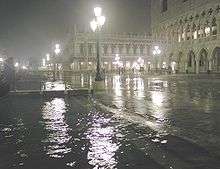
.jpg)
Subsidence, the gradual lowering of the surface of Venice, has led to the seasonal Acqua alta when much of the city's surface is occasionally covered at high tide.
Foundations
The buildings of Venice are constructed on closely spaced wooden piles. Most of these piles are still intact after centuries of submersion. The foundations rest on plates of Istrian limestone placed on top of the piles,[30] and buildings of brick or stone sit above these footings. The piles penetrate a softer layer of sand and mud until they reach a much harder layer of compressed clay.
Submerged by water, in oxygen-poor conditions, wood does not decay as rapidly as on the surface.
Most of these piles were made from trunks of alder trees,[31] a wood noted for its water resistance.[32] The alder came from the westernmost part of today's Slovenia (resulting in the barren land of the Kras region), in two regions of Croatia, Lika and Gorski kotar (resulting in the barren slopes of Velebit) and south of Montenegro.
History
Venice's last two century history is related to Kingdom of Lombardy–Venetia's history, dependent by Austrian Empire State conceived by Chancellor Klemens von Metternich at the beginning of the Restoration which followed the collapse of the Napoleonic empire, whose birth was ratified in 1814 by the Congress of Vienna.
On April 7, 1815 was announced the establishment of the Austrian States in Italy in a New Kingdom of Lombardo-Veneto. It was formed under the Treaty of Vienna aggregating the territories of the suppressed Dukedom of Milan, Duke of Mantua, and Dogado Domini di Terraferma the Republic of Venice, in addition to the Valtellina already part of the Three Leagues, and Oltrepò Ferrara already pontifical, while the State by sea, having already undergone the Serenissima Republic of Vwenice, it was instead it ruled incorporating it directly to the Empire territories.
The Kingdom was given to Francis I of Habsburg-Lorraine, emperor of Austria and King of Lombardy and Veneto. The King and emperor would rule through a viceroy, with residence in Milan and Venice, in the person of Archduke Ranieri, born in Tuscany and younger brother. The population of the Venetians connected to the Austro Hungarian Empire of the Lombardo Veneto have a different ethnic composition Slavic – Germanic from southern and central Italy. This historical period it's also known as Österreichische Italien.
The name of the Lombardo-Veneto was established Austrian Empire 7 April 1815 in the areas gathered in Lombardy and Veneto, received thanks to the decisions of the Congress of Vienna. Previously, and for centuries, Lombardy had been divided between the State of Milan and the Republic of Venice (plus Valtellina played with Graubünden), while Veneto (which also included the Friuli) was entirely included in the territories of the Republic of Venice. The name was chosen at the conclusion of a, not short, debate. The Austrians (or their allies) did not want to keep the name chosen by Napoleon, the Kingdom of Italy. There is no evidence that it considered the phrase Ost und West Italien (Italy Eastern and Western), and even Österreichische Italien (Austrian Italy). On 22–23 March 1848 at the end of the Five Days of Milan, the Austrians were driven from Milan and Venice. After this, Venice becomes the kingdom of St. Mark's and is one of the last to join the unification of the Kingdom of Italy.
The city is often threatened by flood tides pushing in from the Adriatic between autumn and early spring. Six hundred years ago, Venetians protected themselves from land-based attacks by diverting all the major rivers flowing into the lagoon and thus preventing sediment from filling the area around the city. This created an ever-deeper lagoon environment.
In 1604, to defray the cost of flood relief, Venice introduced what could be considered the first example of a 'stamp tax'. When the revenue fell short of expectations in 1608, Venice introduced paper with the superscription 'AQ' and imprinted instructions, which was to be used for 'letters to officials'. At first, this was to be a temporary tax, but it remained in effect until the fall of the Republic in 1797. Shortly after the introduction of the tax, Spain produced similar paper for general taxation purposes, and the practice spread to other countries.
During the 20th century, when many artesian wells were sunk into the periphery of the lagoon to draw water for local industry, Venice began to subside. It was realised that extraction of water from the aquifer was the cause. The sinking has slowed markedly since artesian wells were banned in the 1960s. However, the city is still threatened by more frequent low-level floods (called Acqua alta, "high water") that creep to a height of several centimetres over its quays, regularly following certain tides. In many old houses, the former staircases used to unload goods are now flooded, rendering the former ground floor uninhabitable.
Studies indicate that the city continues sinking at a relatively slow rate of 1-2mm per annum;[33][34] therefore, the state of alert has not been revoked. In May 2003, the Italian Prime Minister Silvio Berlusconi inaugurated the MOSE project (Modulo Sperimentale Elettromeccanico), an experimental model for evaluating the performance of hollow floatable gates; the idea is to fix a series of 78 hollow pontoons to the sea bed across the three entrances to the lagoon. When tides are predicted to rise above 110 centimetres, the pontoons will be filled with air, causing them to float and block the incoming water from the Adriatic Sea. This engineering work is due to be completed by 2016.[35]
Geography

Cannaregio; Castello; Dorsoduro; San Marco; San Polo; Santa Croce.
The whole pensolon (municipality) is divided into 6 boroughs. One of these (the historic city) is divided into six areas called sestieri: Cannaregio, San Polo, Dorsoduro (including the Giudecca and Isola Sacca Fisola), Santa Croce, San Marco (including San Giorgio Maggiore) and Castello (including San Pietro di Castello and Sant'Elena). Each sestiere was administered by a procurator and his staff. Nowadays each sestiere is a statistical and historical area without any degree of autonomy. The six fingers or flanges of the ferro on the bow of a gondola represent the six sestieri.
The sestieri are divided into parishes – initially 70 in 1033, but reduced under Napoleon and now numbering just 38. These parishes predate the sestieri, which were created in about 1170.
Other islands of the Venetian Lagoon do not form part of any of the sestieri, having historically enjoyed a considerable degree of autonomy.
Each sestiere has its own house numbering system. Each house has a unique number in the district, from one to several thousand, generally numbered from one corner of the area to another, but not usually in a readily understandable manner.
Climate
According to the Köppen climate classification, Venice has a Humid subtropical climate (Cfa), with cool winters and very warm summers. The 24-hour average in January is 3.3 °C (37.9 °F), and for July this figure is 23.0 °C (73.4 °F). Precipitation is spread relatively evenly throughout the year, and averages 748 millimetres (29.4 in).
| Climate data for Venice (1971–2000) | |||||||||||||
|---|---|---|---|---|---|---|---|---|---|---|---|---|---|
| Month | Jan | Feb | Mar | Apr | May | Jun | Jul | Aug | Sep | Oct | Nov | Dec | Year |
| Average high °C (°F) | 6.6 (43.9) |
8.6 (47.5) |
12.5 (54.5) |
16.1 (61) |
21.5 (70.7) |
24.9 (76.8) |
27.7 (81.9) |
27.5 (81.5) |
23.5 (74.3) |
18.0 (64.4) |
11.6 (52.9) |
7.4 (45.3) |
17.2 (63) |
| Daily mean °C (°F) | 3.3 (37.9) |
4.7 (40.5) |
8.3 (46.9) |
12.0 (53.6) |
17.1 (62.8) |
20.5 (68.9) |
23.0 (73.4) |
22.6 (72.7) |
18.9 (66) |
13.8 (56.8) |
7.8 (46) |
4.0 (39.2) |
13.0 (55.4) |
| Average low °C (°F) | −0.1 (31.8) |
0.8 (33.4) |
4.1 (39.4) |
7.8 (46) |
12.7 (54.9) |
16.1 (61) |
18.3 (64.9) |
17.7 (63.9) |
14.3 (57.7) |
9.6 (49.3) |
4.0 (39.2) |
0.6 (33.1) |
8.8 (47.8) |
| Average precipitation mm (inches) | 47.0 (1.85) |
48.3 (1.902) |
48.8 (1.921) |
70.0 (2.756) |
66.0 (2.598) |
78.0 (3.071) |
63.9 (2.516) |
64.8 (2.551) |
72.0 (2.835) |
73.5 (2.894) |
65.5 (2.579) |
50.6 (1.992) |
748.4 (29.465) |
| Average precipitation days (≥ 1.0 mm) | 6.0 | 5.2 | 5.7 | 8.3 | 8.2 | 8.6 | 5.9 | 6.1 | 5.9 | 6.7 | 5.8 | 5.9 | 78.3 |
| Average relative humidity (%) | 81 | 77 | 75 | 75 | 73 | 74 | 71 | 72 | 75 | 77 | 79 | 81 | 75.8 |
| Mean monthly sunshine hours | 80.6 | 107.4 | 142.6 | 174.0 | 229.4 | 243.0 | 288.3 | 257.3 | 198.0 | 151.9 | 87.0 | 77.5 | 2,037 |
| Source: MeteoAM (sun and humidity 1961–1990)[36][37] | |||||||||||||
| Jan | Feb | Mar | Apr | May | Jun | Jul | Aug | Sep | Oct | Nov | Dec | Year |
|---|---|---|---|---|---|---|---|---|---|---|---|---|
| 9.9 °C (49.8 °F) | 8.7 °C (47.7 °F) | 9.9 °C (49.8 °F) | 13.5 °C (56.3 °F) | 18.6 °C (65.5 °F) | 23.4 °C (74.1 °F) | 25.4 °C (77.7 °F) | 25.4 °C (77.7 °F) | 23.6 °C (74.5 °F) | 19.3 °C (66.7 °F) | 16.0 °C (60.8 °F) | 13.2 °C (55.8 °F) | 17.2 °C (63.0 °F) |
Government
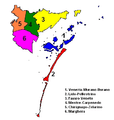 The 6 boroughs of the whole comune of Venice
The 6 boroughs of the whole comune of Venice.svg.png) The whole comune (red) in the Metropolitan City of Venice
The whole comune (red) in the Metropolitan City of Venice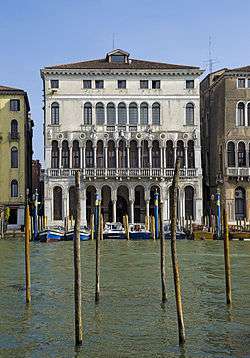 Ca' Loredan, Venice's City Hall
Ca' Loredan, Venice's City Hall
The legislative body of the municipality is the City Council (Consiglio Comunale), which is composed of 45 councillors elected every five years with a proportional system, contextually to the mayoral elections. The executive body is the City Committee (Giunta Comunale), composed of 12 assessors nominated and presided over by a directly elected Mayor.
Venice was governed by center-left parties from the 1990s until the 2010s, when the mayor started to be elected directly. This is remarkable because Veneto has long been a conservative stronghold, with the coalition between the regionalist Lega Nord and the center-right Forza Italia winning absolute majorities of the electorate in many elections at communal, national, and regional levels.
After a corruption scandal that forced the center-left mayor Giorgio Orsoni to resign, Venice voted for the first time in June 2015 for a conservative directly-elected mayor: the center-right businessman Luigi Brugnaro won the election in the second round of voting with the 53% of the votes against the leftist magistrate and member of the Italian Senate Felice Casson, who led in the first round with 38% of the votes.
The municipality of Venice is subdivided into six administrative Boroughs (Municipalità). Each Borough is governed by a Council (Consiglio) and a President, elected contextually to the city Mayor. The urban organization is governed by the Italian Constitution (art. 114). The Boroughs have the power to advise the Mayor with nonbinding opinions on a large spectrum of topics (environment, construction, public health, local markets) and exercise the functions delegated to them by the City Council; in addition they are supplied with autonomous funding to finance local activities. The Boroughs are:
Lagoon area:
- Venezia (historic city)-Murano–Burano (also known as Venezia insulare); population: 69,136;
- Lido–Pellestrina (also known as Venezia litorale); population: 21,664.
Mainland (terraferma), annexed with a Royal Decree, in 1926, to the municipality of Venezia:
- Favaro Veneto; population: 23,615;
- Mestre-Carpenedo (also known as Mestre centro); population: 88,952;
- Chirignago-Zelarino; population: 38;179;
- Marghera; population: 28;466.
After the 2015 elections, five of the six boroughs are governed by the Democratic Party and its allies, and one by the center-right mayoral majority.
Economy
Venice's economy has changed throughout history. Although there is little specific information about the earliest years, it is likely that an important source of the city's prosperity was the trade in slaves, captured in central Europe and sold to North Africa and the Levant. Venice's location at the head of the Adriatic, and directly south of the terminus of the Brenner Pass over the Alps, would have given it a distinct advantage as a middleman in this important trade. In the Middle Ages and the Renaissance, Venice was a major center for commerce and trade, as it controlled a vast sea-empire, and became an extremely wealthy European city, a leader in political and economic affairs and a centre for trade and commerce.[39] From the 11th century until the 15th century, pilgrimages to the Holy Land were offered in Venice. Other ports such as Genoa, Pisa, Marseille, Ancona and Dubrovnik were hardly able to make any competition to the well organized transportation of pilgrims from Venice.[40][41] This all changed by the 17th century, when Venice's trade empire was taken over by other countries such as Portugal, and its naval importance was reduced. In the 18th century, then, it became a major agricultural and industrial exporter. The 18th century's biggest industrial complex was the Venice Arsenal, and the Italian Army still uses it today (even though some space has been used for major theatrical and cultural productions, and spaces for art).[42] Today, Venice's economy is mainly based on tourism, shipbuilding (mainly done in the neighboring cities of Mestre and Porto Marghera), services, trade and industrial exports.[39] Murano glass production in Murano and lace production in Burano are also highly important to the economy.[39]
Tourism
Venice is one of the most important tourist destinations in the world for its celebrated art and architecture.[43] The city has an average of 50,000 tourists a day (2007 estimate).[44] In 2006, it was the world's 28th most internationally visited city, with 2.927 million international arrivals that year.[45]
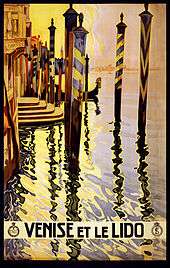
Tourism has been a major sector of Venetian industry since the 18th century, when it was a major center for the Grand Tour, with its beautiful cityscape, uniqueness, and rich musical and artistic cultural heritage. In the 19th century, it became a fashionable centre for the "rich and famous", often staying or dining at luxury establishments such as the Danieli Hotel and the Caffè Florian. It continued being a fashionable city in vogue right into the early 20th century.[43] In the 1980s, the Carnival of Venice was revived and the city has become a major centre of international conferences and festivals, such as the prestigious Venice Biennale and the Venice Film Festival, which attract visitors from all over the world for their theatrical, cultural, cinematic, artistic, and musical productions[43]
Today, there are numerous attractions in Venice, such as St Mark's Basilica, the Grand Canal, and the Piazza San Marco. The Lido di Venezia is also a popular international luxury destination, attracting thousands of actors, critics, celebrities, and mainly people in the cinematic industry. The city also relies heavily on the cruise business.[43] The Cruise Venice Committee has estimated that cruise ship passengers spend more than 150 million euros (US $193 million) annually in the city.[46]
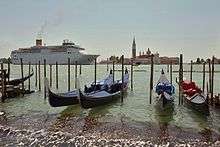
However, Venice's popularity as a major worldwide tourist destination has caused several problems, including the fact that the city can be very overcrowded at some points of the year. It is regarded by some as a tourist trap, and by others as a "living museum".[43] Unlike most other places in Western Europe, and the world, Venice has become widely known for its element of elegant decay. The competition for foreigners to buy homes in Venice has made prices rise so high that numerous inhabitants are forced to move to more affordable areas of Veneto and Italy, the most notable being Mestre.
The need to balance cruise tourism revenues with the protection of the city's fragile canals has seen the Italian Transport Ministry attempt to introduce a ban on large cruise ships visiting the city. The ban would only allow cruise ships smaller than 40,000-gross tons to enter Venice's Giudecca Canal and St Mark's basin.[47] In January, a regional court scrapped the ban, but global cruise lines indicated that they would continue to respect it until a long-term solution for the protection of Venice is found.[48] The city considered a ban on wheeled suitcases, but settled on banning hard wheels for cargo from May 2015.[49]
Transportation
In the historical city
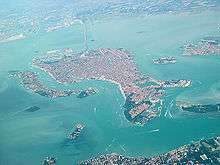
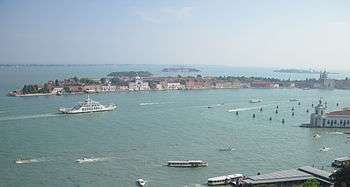
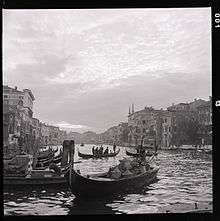
Venice is built on an archipelago of 117 islands formed by 177 canals in a shallow lagoon, connected by 409 bridges.[50] In the old centre, the canals serve the function of roads, and almost every form of transport is on water or on foot. In the 19th century, a causeway to the mainland brought the Venezia Santa Lucia railway station to Venice, and the Ponte della Libertà road causeway and parking facilities (in Tronchetto island and in piazzale Roma) were built during the 20th century. Beyond the road and rail land entrances at the northern edge of the city, transportation within the city remains (as it was in centuries past) entirely on water or on foot. Venice is Europe's largest urban car-free area. Venice is unique in Europe, in having remained a sizable functioning city in the 21st century entirely without motorcars or trucks.
The classical Venetian boat is the gondola, (plural: gondole) although it is now mostly used for tourists, or for weddings, funerals, or other ceremonies, or as 'traghetti' (sing.: traghetto) to cross the Canale Grande in the absence of a nearby bridge. Many gondolas are lushly appointed with crushed velvet seats and Persian rugs. Less well-known is the smaller sandolo. At the front of each gondola that works in the city, there is a large piece of metal called the fèro (iron). Its shape has evolved through the centuries, as documented in many well-known paintings. Its form, topped by a likeness of the Doge's hat, became gradually standardized, and was then fixed by local law. It consists of six bars pointing forward representing the Sestieri of the city, and one that points backward representing the Giudecca.
Waterways
Venice is a city of small islands, enhanced during the Middle Ages by the dredging of soils to raise the marshy ground above the tides. The resulting canals encouraged the flourishing of a nautical culture which proved central to the economy of the city. Today those canals still provide the means for transport of goods and people within the city.
The maze of canals threaded through the city requires the use of more than 400 bridges to permit the flow of foot traffic. In 2011, the city opened Ponte della Costituzione, the fourth bridge across the Grand Canal, connecting the Piazzale Roma bus terminal area with the Stazione Ferroviaria (train station), the others being the original Ponte di Rialto, the Ponte dell'Accademia, and the Ponte degli Scalzi.
Public transport
Azienda del Consorzio Trasporti Veneziano (ACTV) is a public company responsible for public transportation in Venice.
Lagoon area
The main public transportation means are motorised waterbuses (vaporetti) which ply regular routes along the Grand Canal and between the city's islands. The only gondole still in common use by Venetians are the traghetti, foot passenger ferries crossing the Grand Canal at certain points without bridges.
The Venice People Mover (managed by ASM) is a cable-operated public transit system connecting Tronchetto island with Piazzale Roma. Water taxis are also active.
Lido and Pellestrina islands
Lido and Pellestrina are two islands forming a barrier between the southern Venetian Lagoon and the Adriatic Sea. In those islands, road traffic is allowed. There are bus services on islands and waterbus services linking islands with other islands (Venice, Murano, Burano) and with the peninsula of Cavallino-Treporti.
Mainland
The mainland of Venice is composed of 5 boroughs: Mestre-Carpenedo, Marghera, Chirignago-Zelarino and Favaro Veneto. Mestre is the center and the most populated urban area of the mainland of Venice. There are several bus routes and two Translohr tramway lines. Several bus routes and one of the above tramway lines link the mainland with Piazzale Roma, the main bus station in Venice, via Ponte della Libertà, a road bridge connecting the mainland with the group of islands that comprise the historic center of Venice.
 Vaporetto in Venice
Vaporetto in Venice People Mover in Venice
People Mover in Venice- Bus in Mestre
Trains
Venice has regional and national trains, including trains to Rome (3.5 hours) and Milan (2.5 hours). Treviso is 35 minutes away.[51] Florence and Padua are two of the stops between Rome and Venice. There are two main stations:
- The St Lucia station is a few steps away from a vaporetti stop in the historic city next to Piazzale Roma. As well as many more local trains, this station is the terminus of the Venice Simplon Orient Express from Paris and London.
- The Mestre station is on the mainland, on the border between the boroughs of Mestre and Marghera.
Both stations are managed by Grandi Stazioni; they are linked by the Ponte della Libertà (Liberty Bridge) between the mainland and the islands.
Others small stations in the municipality are: Venezia Porto Marghera, Venezia Carpenedo, Venezia Mestre Ospedale, Venezia Mestre Porta Ovest.
Airports
Venice is served by the Marco Polo International Airport (Aeroporto di Venezia Marco Polo), named in honor of its noted citizen. The airport is on the mainland and was rebuilt away from the coast. Public transport from the airport takes one to:
- Venice Piazzale Roma by ATVO (provincial company) buses[52] and by ACTV (city company) buses (route 5 aerobus);[53]
- Venice, Lido and Murano by Alilaguna (private company) motor boats;
- Mestre, the mainland and Venice Mestre railway station (convenient for connections to Milan, Padova, Trieste, Verona and the rest of Italy) by ACTV lines (route 15 and 45)[53] and by ATVO lines;
- regional destinations (Treviso, Padua, the beach, ...) by ATVO buses and by Busitalia Sita Nord[54] buses (national company).
Some airlines market Treviso Airport in Treviso, 30 kilometres (19 mi) from Venice, as a Venice gateway. Some simply advertise flights to "Venice", while naming the actual airport only in small print.[55] There are public buses from the airport to Venice from this airport.
Venezia-Lido "Giovanni Nicelli",[56] a public airport suitable for smaller aircraft, is at the NE end of Lido di Venezia. It has a 994-metre grass runway.
Sport
The main football club in the city is FBC Unione Venezia, founded in 1907, who currently plays in the Lega Pro Prima Divisione. Their ground, the Stadio Pierluigi Penzo situated in Sant'Elena, is one of the oldest venues in Italy.
The local basketball team, Reyer Venezia Mestre, plays in the first national league, the Lega Basket Serie A.
Education
Venice is a major international centre for higher education. The city hosts the Ca' Foscari University of Venice, founded in 1868;[57] the IUAV University of Venice, founded in 1926;[58] the Venice International University, an international research center, founded in 1995 and located on the island of San Servolo;[59] and the EIUC-European Inter-University Centre for Human Rights and Democratisation, located on the island of Lido di Venezia.[60]
Other Venetian institutions of higher education are: the "Accademia di Belle Arti" (Academy of Fine Arts), established in 1750, whose first Chairman was Giovanni Battista Piazzetta;[61] and the "Benedetto Marcello" Conservatory of Music, which, established in 1876 as High School and Musical Society, later (1915) became "Liceo Musicale" and finally (1940), when its Director was Gian Francesco Malipiero, State Conservatory of Music.[62]
Demographics
| Historical population | ||
|---|---|---|
| Year | Pop. | ±% |
| 1000 | 60,000 | — |
| 1200 | 80,000 | +33.3% |
| 1300 | 180,000 | +125.0% |
| 1400 | 110,000 | −38.9% |
| 1423 | 150,000 | +36.4% |
| 1500 | 100,000 | −33.3% |
| 1560 | 170,000 | +70.0% |
| 1600 | 200,000 | +17.6% |
| 1700 | 140,000 | −30.0% |
| 1800 | 140,000 | +0.0% |
The city was one of the largest in Europe in the High Middle Ages, with a population of 60,000 in AD 1000; 80,000 in 1200; and rising up to 110,000–180,000 in 1300. In the mid 1500s the city's population was 170,000, and by 1600 almost 200,000.[63][64][65][66][67]
In 2009, there were 270,098 people residing in Venice's comune (the population estimate of 272,000 inhabitants includes the population of the whole Comune of Venezia; around 60,000 in the historic city of Venice (Centro storico); 176,000 in Terraferma (the Mainland); and 31,000 live on other islands in the lagoon), of whom 47.4% were male and 52.6% were female. Minors (children ages 18 and younger) were 14.36% of the population compared to pensioners who numbered 25.7%. This compared with the Italian average of 18.06% (minors) and 19.94% (pensioners). The average age of Venice residents was 46 compared to the Italian average of 42. In the five years between 2002 and 2007, the population of Venice declined by 0.2%, while Italy as a whole grew by 3.85%.[68] The population in the historic old city declined much faster: from about 120,000 in 1980 to about 60,000 in 2009,[69] and to below 55,000 in 2016.[70]
As of 2009, 91% of the population was Italian. The largest immigrant group came from other European nations: (Romanians, the largest group: 3%, South Asia: 1.3%, and East Asia: 0.9%).
Venice is predominantly Roman Catholic (92.7% of resident population in the area of the Roman Catholic Archdiocese of Venice in 2012[71]), but because of the long-standing relationship with Constantinople, there is also a noticeable Orthodox presence, and as a result of immigration, there are now some Muslim, Hindu and Buddhist inhabitants. There is also a historic Jewish community in Venice. The Venetian Ghetto was the area in which Jews were compelled to live under the Venetian Republic. The word ghetto, originally Venetian, is now used in many languages. Shakespeare's play The Merchant of Venice, written in the late 16th century, features Shylock, a Venetian Jew. The first complete and uncensored printed edition of the Talmud was printed in Venice by Daniel Bomberg in 1523. In more modern times, Venice has an eruv,[72] used by the Jewish community.
Culture
Cinema, media, and popular culture
Venice has been the setting or chosen location of numerous films, games, works of literature, music videos, novels, poems, television shows, and other cultural references.
In literature and adapted works
The city is a particularly popular setting for essays, novels, and other works of fictional or non-fictional literature. Examples of these include: Casanova's autobiographical History of My Life, Ben Jonson's Volpone (1605–6), Anne Rice's Cry to Heaven (1982), Shakespeare's Merchant of Venice (ca. 1596–1598) and Othello, Philippe Sollers' Watteau in Venice, and Voltaire's Candide. Additionally, Thomas Mann's novella, Death in Venice (1912), was the basis for Benjamin Britten's opera Death in Venice.
Films
Examples of films set or shot in Venice include:
- Luchino Visconti's Death in Venice[73]
- Three James Bond films: From Russia with Love, Moonraker, and Casino Royale (2006)
- The Tourist (2010)
- The Italian Job (2003)
- Summertime (1955), starring Katharine Hepburn
- Fellini's Casanova
- Nicolas Roeg's Don't Look Now
- The Wings of the Dove
- Indiana Jones and the Last Crusade
- The League of Extraordinary Gentlemen
- A Little Romance
- Lara Croft: Tomb Raider
- The Talented Mr. Ripley (1999)
- Dangerous Beauty (1988), the biography of Veronica Franco, the 16th century beauty
- Penguins of Madagascar
In games
The city is the setting for such video games as Assassin's Creed II and Tomb Raider II.
In music
The city has been the setting for the music videos of Madonna's "Like a Virgin" and Siouxsie and the Banshees' "Dear Prudence" .
Architecture
.jpg)

Venice has a rich and diverse architectural style, the most prominent of which is the Gothic style. Venetian Gothic architecture is a term given to a Venetian building style combining use of the Gothic lancet arch with Byzantine and Ottoman influences. The style originated in 14th-century Venice, where the confluence of Byzantine style from Constantinople met Arab influence from Moorish Spain. Chief examples of the style are the Doge's Palace and the Ca' d'Oro in the city. The city also has several Renaissance and Baroque buildings, including the Ca' Pesaro and the Ca' Rezzonico.
Music
The city of Venice in Italy has played an important role in the development of the music of Italy. The Venetian state – i.e., the medieval Maritime Republic of Venice – was often popularly called the "Republic of Music", and an anonymous Frenchman of the 17th century is said to have remarked that "In every home, someone is playing a musical instrument or singing. There is music everywhere."[74]
During the 16th century, Venice became one of the most important musical centers of Europe, marked by a characteristic style of composition (the Venetian school) and the development of the Venetian polychoral style under composers such as Adrian Willaert, who worked at St Mark's Basilica. Venice was the early center of music printing; Ottaviano Petrucci began publishing music almost as soon as this technology was available, and his publishing enterprise helped to attract composers from all over Europe, especially from France and Flanders. By the end of the century, Venice was known for the splendor of its music, as exemplified in the "colossal style" of Andrea and Giovanni Gabrieli, which used multiple choruses and instrumental groups. Venice was also the home of many noted composers during the baroque period, such as Antonio Vivaldi, Ippolito Ciera, Giovanni Picchi, and Girolamo Dalla Casa, to name but a few.
Interior design
It can be argued that Venice produced the best and most refined rococo designs. At the time, Venice was in trouble. It had lost most of its maritime power, was lagging behind its rivals in political importance, and society had become decadent, with nobles wasting their money in gambling and partying. But Venice remained Italy's fashion capital, and was a serious contender to Paris in terms of wealth, architecture, luxury, taste, sophistication, trade, decoration, style, and design.[75] Venetian rococo was well known as rich and luxurious, with usually very extravagant designs. Unique Venetian furniture pieces included the divani da portego, and long rococo couches and pozzetti, objects meant to be placed against the wall. Bedrooms of rich Venetians were usually sumptuous and grand, with rich damask, velvet, and silk drapery and curtains, and beautifully carved rococo beds with statues of putti, flowers and angels.[75] Venice was especially known for its beautiful girandole mirrors, which remained among, if not the, finest in Europe. Chandeliers were usually very colourful, using Murano glass to make them look more vibrant and stand out from others, and precious stones and materials from abroad were used, since Venice still held a vast trade empire. Lacquer was very common, and many items of furniture were covered with it, the most noted being lacca povera (poor lacquer), in which allegories and images of social life were painted. Lacquerwork and Chinoiserie were particularly common in bureau cabinets.[76]
Fashion and shopping
In the 14th century, many young Venetian men began wearing tight-fitting multicoloured hose, the designs on which indicated the Compagnie della Calza ("Trouser Club") to which they belonged. The Venetian Senate passed sumptuary laws, but these merely resulted in changes in fashion in order to circumvent the law. Dull garments were worn over colourful ones, which then were cut to show the hidden colours resulting in the wide spread of men's "slashed" fashions in the 15th century.
Today, Venice is a major fashion and shopping centre, not as important as Milan, Florence, and Rome, but on a par with Verona, Turin, Vicenza, Naples, and Genoa. Roberta di Camerino is the only major Italian fashion brand to be based in Venice.[77] Founded in 1945, it is renowned for its innovative handbags featuring hardware by Venetian artisans and often covered in locally woven velvet, and has been credited with creating the concept of the easily recognisable status bag.[77] Many of the fashion boutiques and jewelry shops in the city are located on or near the Rialto Bridge and in the Piazza San Marco. There are Louis Vuitton and Ermenegildo Zegna flagship stores in the city. If shopping for venetian and Italian food specialties and wine you can head to Mascari or Casa del Parmigiano near Rialto and I Tre Mercanti flagship store near Piazza San Marco.
Cuisine
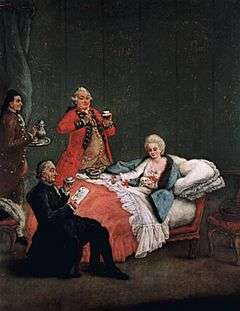
Venetian cuisine is characterized by seafood, but also includes garden products from the islands of the lagoon, rice from the mainland, game, and polenta. Venice combines local traditions with influences stemming from age-old contacts with distant countries. These include sarde in saór (sardines marinated to preserve them for long voyages); bacalà mantecato (a recipe based on Norwegian stockfish and extra-virgin olive oil); bisàto (marinated eel); risi e bisi, rice, peas and (not smoked) bacon;[78] fegato alla veneziana, Venetian-style veal liver; risòto col néro de sépe (risotto with cuttlefish, blackened by their ink); cicchétti, refined and delicious tidbits (akin to tapas); antipasti (appetizers); and prosecco, an effervescent, mildly sweet wine.
In addition, Venice is known for the golden, oval-shaped cookies called baìcoli, and for other types of sweets, such as: pan del pescatore (bread of the fisherman); cookies with almonds and pistachio nuts; cookies with fried Venetian cream, or the bussolài (butter biscuits and shortbread made in the shape of a ring or of an "S") from the island of Burano; the galàni or cróstoli (angel wings);[79] the frìtole (spherical doughnuts); the fregolòtta (a crumbly cake with almonds); a milk pudding called rosada; and cookies called zaléti, whose ingredients include yellow maize flour.[80]
The dessert tiramisù is thought to have been invented in Treviso in the late 1960s, and is popular in the Veneto area.
Literature

Venice has long been a source of inspiration for authors, poets and playwrights as well as being at the forefront of the technical developing of printing and publishing.
Two of the most noted Venetian writers were Marco Polo in the Middle Ages and later Giacomo Casanova. Polo (1254–1324) was a merchant who voyaged to the Orient. His series of books, co-written by Rustichello da Pisa, titled Il Milione provided important knowledge of the lands east of Europe, from the Middle East to China, Japan and Russia. Giacomo Casanova (1725–1798) was a prolific writer and adventurer best remembered for his autobiography, Histoire De Ma Vie (Story of My Life), which links his colourful lifestyle to the city of Venice.
Venetian playwrights followed the old Italian theatre tradition of Commedia dell'arte. Ruzante (1502–1542), Carlo Goldoni (1707–1793) and Carlo Gozzi (1720–1806) used the Venetian dialect extensively in their comedies.
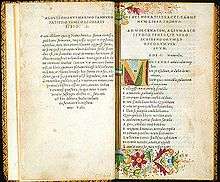
Venice has also inspired writers from abroad. Shakespeare set Othello and The Merchant of Venice in the city. Thomas Mann wrote the novel Death in Venice, published in 1912. Venice inspired the poetry of Ezra Pound, who wrote his first literary work in the city. Pound died in 1972 and his remains are buried in Venice's cemetery island of San Michele. The French writer Philippe Sollers spent most of his life in Venice and published A Dictionary For Lovers Of Venice in 2004. Ugo Foscolo (1778–1827), born in Zante, an island that at the time belonged to the Republic of Venice, was also a poet and revolutionary who wanted to see a free republic established in Venice following its fall to Napoleon. The city features prominently in Henry James' The Aspern Papers and The Wings of the Dove, and is also visited in Evelyn Waugh's Brideshead Revisited and Marcel Proust's In Search of Lost Time. Perhaps the most known children's book set in Venice is The Thief Lord, written by the German author Cornelia Funke.
Venice is also linked to the technological aspects of writing. The city was the location of one of Italy's earliest printing presses, established by Aldus Manutius (1449–1515). From this beginning Venice developed as an important typographic center and even as late as the 18th century was responsible for printing half of Italy's published books.
Art and printing
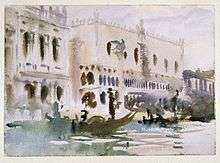

Venice, especially during the Middle Ages and the Renaissance and Baroque periods, was a major centre of art and developed a unique style known as the Venetian School. In the Middle Ages and the Renaissance, Venice, along with Florence and Rome, became one of the most important centres of art in Europe, and numerous wealthy Venetians became patrons of the arts. Venice at the time was a rich and prosperous Maritime Republic, which controlled a vast sea and trade empire.[81]
By the end of the 15th century, Venice had become the European capital of printing, being one of the first cities in Italy (after Subiaco and Rome) to have a printing press after those established in Germany, having 417 printers by 1500. The most important printing office was the Aldine Press of Aldus Manutius, which in 1499 printed the Hypnerotomachia Poliphili, considered the most beautiful book of the Renaissance, and established modern punctuation, the page format and italic type, and the first printed work of Aristotle.
In the 16th century, Venetian painting was developed through influences from the Paduan School and Antonello da Messina, who introduced the oil painting technique of the Van Eyck brothers. It is signified by a warm colour scale and a picturesque use of colour. Early masters were the Bellini and Vivarini families, followed by Giorgione and Titian, then Tintoretto and Veronese. In the early 16th century, there was rivalry in Venetian painting between the disegno and colorito techniques.[82]
Canvases (the common painting surface) originated in Venice during the early Renaissance. These early canvases were generally rough.
In the 18th century, Venetian painting had a revival with Tiepolo's decorative painting and Canaletto's and Guardi's panoramic views.
Glass
Venice is known for its ornate glass-work, known as Venetian glass. It is world-renowned for being colourful, elaborate, and skilfully made.
Many of the important characteristics of these objects had been developed by the 13th century. Toward the end of that century, the center of the Venetian glass industry moved to Murano, an offshore island in Venice. The glass made there is known as Murano glass.
Byzantine craftsmen played an important role in the development of Venetian glass, an art form for which the city is well known. When Constantinople was sacked in the Fourth Crusade in 1204, some fleeing artisans came to Venice. This happened again when the Ottomans took Constantinople in 1453, supplying Venice with still more glassworkers. By the 16th century, Venetian artisans had gained even greater control over the color and transparency of their glass, and had mastered a variety of decorative techniques.
Despite efforts to keep Venetian glassmaking techniques within Venice, they became known elsewhere, and Venetian-style glassware was produced in other Italian cities and other countries of Europe.
Some of the most important brands of glass in the world today are still produced in the historical glass factories on Murano. They are: Venini, Barovier & Toso, Pauly, Millevetri, Seguso.[83] Barovier & Toso is considered one of the 100 oldest companies in the world, formed in 1295.
Festivals

The Carnival of Venice is held annually in the city, It lasts for around two weeks and ends on Shrove Tuesday. Venetian masks are worn.
The Venice Biennale is one of the most important events in the arts calendar. In 1895 an Esposizione biennale artistica nazionale (biennial exhibition of Italian art) was inaugurated.[84] The activities of the Biennale were interrupted by the war in September 1942, but resumed in 1948.[85]
The Festa del Redentore is held in mid July. It began as a feast to give thanks for the end of the plague of 1576. A bridge of barges is built connecting Giudecca to the rest of Venice, and fireworks play an important role.
The Venice Film Festival (Italian Mostra Internazionale d'Arte Cinematografica di Venezia) is the oldest film festival in the world. Founded by Count Giuseppe Volpi di Misurata in 1932 as the Esposizione Internazionale d'Arte Cinematografica, the festival has since taken place every year in late August or early September on the island of the Lido. Screenings take place in the historic Palazzo del Cinema on the Lungomare Marconi. It is one of the world's most prestigious film festivals and is part of the Venice Biennale.
Foreign words of Venetian origin
Some words with a Venetian etymology include arsenal, ciao, ghetto, gondola, imbroglio, lagoon, lazaret, lido, Montenegro, and regatta. The name "Venezuela" is a Spanish diminutive of Venice. Many additional places around the world are named after Venice, e.g., Venice, Los Angeles, home of Venice Beach, California.
Notable people
For people from Venice, see Category:People from Venice. Others closely associated with the city include:
- Pietro Cesare Alberti (1608–1655), considered the first Italian-American, arriving in New Amsterdam in 1635.
- Tomaso Albinoni (8 June 1671 – 17 January 1751), a baroque composer.
- Claudio Ambrosini (9 April 1948), composer and conductor.
- Pietro Bembo (20 May 1470 – 18 January 1547), cardinal and scholar.
- Giovanni Bellini (c. 1430–1516), a Renaissance painter, probably the best known of the Bellini family of painters.
- Francesco Borgato (5 September 1990, Venice), is an Italian recording artist and dancer.
- Marco Antonio Bragadin (d.1571), general, flayed alive by the Turks after a fierce resistance during the siege of Famagusta.
- Sebastian Cabot (c. 1484–1557, or soon after), explorer.
- Rosalba Carriera (7 October 1675 – 15 April 1757), known for her pastel works.
- Canaletto (28 October 1697 – 19 April 1768), known for his landscapes or vedute of Venice, but not only.
- Giacomo Casanova (1725–1798 in Dux, Bohemia, (now Duchcov, Czech Republic)), a Venetian adventurer, writer and womanizer.
- Francesco Cavalli (14 February 1602 – 14 January 1676), a baroque composer.
- Lorenzo Da Ponte (1749–1838), opera librettist and poet. He wrote the librettos for 28 operas by 11 composers, including Wolfgang Amadeus Mozart.
- Enrico Dandolo (c. 1107, 1205), Doge of Venice from 1192 to his death. He played a direct role in the Sack of Constantinople during the Fourth Crusade.
- Vincenzo Dandolo (1758–1819), chemist, agronomist and politician of the Enlightenment Era.
- Ludovico de Luigi (November 1933), Venetian Surrealistic artist.
- Pellegrino Ernetti, Catholic priest and exorcist.
- Veronica Franco (1546–1591), poet and courtesan during the Renaissance.
- Andrea Gabrieli (c. 1510–1586), Italian composer and organist at St Mark's Basilica.
- Giovanni Gabrieli (between 1554 and 1557–1612), composer and organist at St Mark's Basilica.
- Carlo Goldoni (25 February 1707 – 6 February 1793). Along with Pirandello, Goldoni is probably the most notable name in Italian theatre, in his country and abroad.
- Carlo Gozzi (13 December 1720 – 4 April 1806), an excellent dramatist of the 18th century.
- Pietro Guarneri (14 April 1695 – 7 April 1762) left Cremona in 1718, settled in Venice. "Peter of Venice" from the family of great luthiers.
- Baldassare Longhena (1598 – 18 February 1682), one of the greatest exponents of Baroque architecture.
- Lorenzo Lotto (c. 1480 – Loreto, 1556), painter, draughtsman, and illustrator, traditionally placed in the Venetian school.
- Bruno Maderna (21 April 1920 – 13 November 1973), an Italian-German orchestra director and 20th-century music composer.
- Diogo Mainardi (22 September 1962, São Paulo), is a Brazilian writer, journalist and TV commentator.
- Aldus Manutius (1449–1515), one of the most important printers in history.
- Leon Modena (1571–1648) preacher, author, poet, active in the Venetian ghetto and beyond.
- Claudio Monteverdi (1567–1643), composer, opera pioneer, and director of music at San Marco.
- Luigi Nono (29 January 1924 – 8 May 1990), a leading composer of instrumental and electronic music.
- Joseph Pardo (c. 1561–1619), rabbi and merchant.
- Elena Lucrezia Cornaro Piscopia (5 June 1646 – 26 July 1684), the first woman in the world to receive a doctorate degree.
- Marco Polo (c. 1254 – 8 January 1324), trader and explorer, one of the first Westerners to travel the Silk Road to China. While a prisoner in Genoa, he dictated in the tale of his travels known as Il Milione (The Travels of Marco Polo).
- Virgilio Ranzato (7 May 1883 – 20 April 1937), composer.
- Frederick Rolfe (22 July 1860 – 25 October 1913), English author of the Venetian novel The Desire and Pursuit of the Whole.
- Carlo Scarpa (2 June 1906 – 1978, Sendai, Japan), an architect with a profound understanding of materials.
- Romano Scarpa (27 September 1927, Venice – 23 April 2005, Málaga), was one of the most noted Italian creators of Disney comics.
- Giuseppe Sinopoli (2 November 1946 – 20 April 2001), conductor and composer.
- Giovanni Battista Tiepolo (5 March 1696 – 27 March 1770), the last "Grand Manner" fresco painter from the Venetian Republic.
- Tintoretto (1518 – 31 May 1594), probably the last great painter of Italian Renaissance.
- Titian (c. 1488–90 – 27 August 1576), leader of the 16th-century Venetian school of the Italian Renaissance (he was born in Pieve di Cadore).
- Elisabetta Caminèr Turra (1751–1796), writer.
- Emilio Vedova (9 August 1919 – 25 October 2006), one of the most important modern painters of Italy.
- Sebastiano Venier, (c. 1496 – 3 March 1578), Doge of Venice from 11 June 1577 to 1578.
- Antonio Vivaldi (4 March 1678, 28 July (or 27), 1741, Vienna), composer and violinist of the Baroque Era.
International relations
The City of Venice and the Central Association of Cities and Communities of Greece (KEDKE) established, in January 2000, in pursuance of the EC Regulations n. 2137/85, the European Economic Interest Grouping (E.E.I.G.) Marco Polo System to promote and realise European projects within transnational cultural and tourist field, particularly referred to the artistic and architectural heritage preservation and safeguard.
Twin towns and sister cities
Venice is twinned with:
-
 Shiraz, Iran
Shiraz, Iran -
 Islamabad, Pakistan, since 1960
Islamabad, Pakistan, since 1960 -
 Palembang, Indonesia.
Palembang, Indonesia. -
 Suzhou, China, since 1980
Suzhou, China, since 1980 -
 Bangkok, Thailand
Bangkok, Thailand -
 Tallinn, Estonia
Tallinn, Estonia -
 Pereira, Colombia
Pereira, Colombia -
 Sarajevo, Bosnia and Herzegovina, since 1994
Sarajevo, Bosnia and Herzegovina, since 1994 -
 Yerevan, Armenia, since 2011[86]
Yerevan, Armenia, since 2011[86] -
 Banjarmasin, Indonesia.
Banjarmasin, Indonesia. -
 Tigre, Buenos Aires, Argentina
Tigre, Buenos Aires, Argentina -
 Fort Lauderdale, United States, since 2007
Fort Lauderdale, United States, since 2007 -
 Wolverhampton, United Kingdom
Wolverhampton, United Kingdom -
 Most, Czech Republic
Most, Czech Republic -
 Dubrovnik, Croatia, since 2012
Dubrovnik, Croatia, since 2012
In 2013, Venice ended the sister city relationship with St. Petersburg in opposition to laws Russia had passed against homosexuals and those who support gay rights.[87]
Cooperation agreements
Venice has cooperation agreements with the Greek city of Thessaloniki, the German city of Nuremberg, signed on 25 September 1999, and the Turkish city of Istanbul, signed on 4 March 1993, within the framework of the 1991 Istanbul Declaration. It is also a Science and Technology Partnership City with Qingdao, China.
See also
- History of the Jews in Venice
- List of buildings and structures in Venice
- List of painters and architects of Venice
- List of places called Venice of the East
- Outline of Italy
- Republic of Venice
- Su e zo per i ponti
- Veneti and Venetic language (the ancient spoken language of the region)
- Venetian Blinds
- Venetian Ghetto
- Venetian language (the modern spoken vernacular of the region)
- Venezia F.C.
- Venezia Mestre Rugby FC – rugby team
- Venice of the North
References
Notes
- 1 2 3 "Venice and its Lagoon". UNESCO. Retrieved April 17, 2012.
- ↑ "Patreve, l'attuale governance non funziona" (PDF). Corriere Della Sera. March 6, 2011. Retrieved October 6, 2016.
- ↑ "Online Etymology Dictionary". Retrieved 11 June 2010.
- ↑ Richard Stephen Charnock (1859). Local etymology: a derivative dictionary of geographical names. Houlston and Wright. p. 288.
- ↑ Coispeau, Olivier (2016-08-10). Finance Masters: A Brief History of International Financial Centers in the Last Millennium. World Scientific. ISBN 9789813108844.
- ↑ "Venetian Music of the Renaissance". Vanderbilt.edu. 11 October 1998. Archived from the original on 14 June 2009. Retrieved 22 April 2010.
- ↑ Chambers, David (1992). Venice: A Documentary History. England: Oxford. p. 78. ISBN 0-8020-8424-9.
- ↑ "Dizionario d'ortografia e di pronunzia". rai.it.
- ↑ "Imperciocchè nascendi i principati", begins Apostolo Zeno, Compendio della storia Veneta di Apostolo Zeno continuata fino alla caduta della repubblica 1847:9.
- ↑ Bosio, Le origini di Venezia
- ↑ Zeno, Compendio 1847:10.
- ↑ Trudy Ring; Robert M. Salkin; Sharon La Boda (1 January 1996). International Dictionary of Historic Places: Southern Europe. Taylor & Francis. p. 745. ISBN 978-1-884964-02-2. Retrieved 24 March 2011.
- ↑ Traditional date as given in William J. Langer, ed. An Encyclopedia of World History.
- ↑ John Julius Norwich, A History of Venice (Alfred A. Knopf: New York, 1982) p. 13.
- ↑ Alethea Wiel, A History of Venice, (London) 1898, reprinted Barnes & Noble Books (New York) 1995, pp. 26–27.
- ↑ Langer
- ↑ Thomas F. Madden, Venice: A New History, Penguin, 2013, ISBN 978-0-670-02542-8.
- ↑ "Piracy as an Islamic-Christian Interface in the Thirteenth Century".
- ↑ Richard Cowen, The importance of salt
- ↑ Herrin, Byzantium: The Surprising Life of a Medieval Empire, Penguin, Harmondsworth, ISBN 978-0-14-103102-6
- ↑ "History of Venice". Historyworld.net. Retrieved 28 March 2009.
- ↑ Thomas F. Madden, Enrico Dandolo and the Rise of Venice, Johns Hopkins University Press, ISBN 978-0-8018-8539-6
- ↑ James Burke, Connections (Little, Brown and Co., 1978/1995, ISBN 978-0-316-11672-5, p.105
- ↑ William J. Bernstein (2009). "A Splendid Exchange: How Trade Shaped the World". Grove Press. p.143. ISBN 0-8021-4416-0
- ↑ State of Texas, Texas Department of State Health Services. "History of Plague". Dshs.state.tx.us. Retrieved 28 March 2009.
- ↑ "Medicine and society in early modern Europe". Mary Lindemann (1999). Cambridge University Press. p.41. ISBN 0-521-42354-6
- ↑ "Group Captain George Westlake". The Daily Telegraph. London. 26 January 2006. Retrieved 13 June 2013.
- ↑ Patrick G. Skelly, Pocasset MA (6 May 2005). "US Army Air Force Operations Mediterranean Theater". Milhist.net. Retrieved 27 July 2010.
- ↑ Patrick G. Skelly, Pocasset MA (21 July 1945). "New Zealand troops relieve Venice". Milhist.net. Retrieved 28 March 2009.
- ↑ Standish, Dominic (2003). "Barriers to barriers: why environmental precaution has delayed mobile floodgates to protect Venice". In Okonski, Kendra. Adapt or die: the science, politics and economics of climate change. London: Profile Books. p. 40. ISBN 978-1-86197-795-3. Retrieved 28 November 2014.
- ↑ Kendall, Paul (25 August 2010). "Mythology and Folklore of the Alder". Trees for life. Archived from the original on 5 August 2011. Retrieved 6 August 2011.
- ↑ "Alder – Alnus glutinosa". Conservation Volunteers Northern Ireland. Retrieved 6 August 2011.
- ↑ http://sciences.blogs.liberation.fr/files/venise-senfonce.pdf
- ↑ "City of Venice – Subsidence and eustatism". comune.venezia.it. Archived from the original on 11 September 2015.
- ↑ "'Moses project' to secure future of Venice". The Daily Telegraph. London. 11 January 2012. Retrieved 11 January 2012.
- ↑ "Venezia/Tessera" (PDF). Italian Air Force National Meteorological Service. Retrieved 5 December 2013.
- ↑ "Tabella CLINO". MeteoAM. Retrieved 22 June 2013.
- ↑ Venice Sea Temperature – seatemperature.org
- 1 2 3 "The economy of Venice, Italy". Aboutvenice.org. Retrieved 22 April 2010.
- ↑ Pilgerreisen von Venedig nach Jerusalem im späten Mittelalter- Die Verträge mit dem Schiffspatron, Seite 2, Fabian H. Flöper, GRIN Verlag, 2011. ISBN 978-3-656-04783-4
- ↑ Venice, page 71, Beryl D. De Sélincourt, May (Sturge) Gretton, Chatto & Windus, London 1907., reprinted BiblioBazaar 2010, ISBN 978-1-177-40448-8
- ↑ "Venice (Italy) :: Economy – Britannica Online Encyclopedia". Britannica.com. Retrieved 22 April 2010.
- 1 2 3 4 5 "Venice (Italy) :: Economy – Britannica Online Encyclopedia". Britannica.com. Retrieved 22 April 2010.
- ↑ Owen, Richard (5 April 2007). "Venice in peril as the tourists flood in and locals get out". The Times. London. Retrieved 27 May 2010.
- ↑ "Top 150 City Destinations London Leads the Way". Euromonitor.com. 11 October 2007. Archived from the original on 4 September 2009. Retrieved 22 April 2010.
- ↑ "Tourism overwhelms vanishing Venice". DW.de. Retrieved 13 January 2015.
- ↑ "Italy to ban large cruise ships in Venice". The Telegraph. Retrieved 13 January 2015.
- ↑ "CLIA says cruise lines will continue to respect Venice cruise ship ban despite new ruling". Cruise Arabia & Africa. Retrieved 13 January 2015.
- ↑ "Turistby indfører forbud mod larmende kufferthjul". jyllands-posten.dk. Archived from the original on 25 November 2015.
- ↑ "Venice Study Abroad". Retrieved 6 October 2010.
- ↑ Thomas Cook European Timetables
- ↑ "ATVO". Atvo.it. Retrieved 26 August 2012.
- 1 2 "Linee Urbane". www.actv.it. Retrieved 26 August 2012.
- ↑ http://www.fsbusitalia.it/cms-instance/documenti/fsbusitalia/Montegrotto-AeropMarcoPolo.pdf
- ↑ Home Page Archived 15 December 2007 at the Wayback Machine.", Wizz Air
- ↑ www.enav.it
- ↑ DEPARTMENTS: Asian and North African Studies; Economics; Environmental Sciences, Informatics and Statistics; Humanities; Linguistics and Comparative Cultural Studies; Management; Molecular Sciences and Nanosystems; Philosophy and Cultural Heritage. INTERDEPARTMENTAL SCHOOLS: School of Asian Studies and Business Management; School of Cultural Production and Conservation of the Cultural Heritage; School of International Relations; School of Social Work and Public Policies. OTHER SCHOOLS: School of Economics; CFCS – Ca’ Foscari Challenge School; CFSIE – Ca’ Foscari School for International Education; Ca' Foscari Graduate School.
- ↑ DEPARTMENTS: DACC – Architecture, Construction and Conservation; DCP – Architecture and Arts; DPPAC – Design and Planning in Complex Environments.
- ↑ Courses. ITALY: History of Venice; Italian Contemporary History in Films; Art and Architecture in Renaissance Venice; Italian Fashion and Design. CULTURES OF THE WORLD: Intercultural Communication; Gender Studies; Comparing East and West. GLOBAL CHALLENGES: Identity, Heritage and Globalization; Globalization, Ethics, Welfare and Human Rights; Global governance for peace and security, cooperation and development.
- ↑ European Master's Degree in Human Rights and Democratisation.
- ↑ DEPARTMENTS: Visual arts (Painting; Sculpture; Graphic Art; Decoration); Scenography and Applied Arts (Scenography; New Technologies for the Arts).
- ↑ DEPARTMENTS: Theory and Analysis, Composition and Conducting: Pre-polyphonic Music, Choral Music and Choir Conducting, Composition, Experimental Composition, Conducting. New Technologies and Musical Languages: Jazz, Electronic Music. Wind instruments: Recorder, Flute, Trumpet, French Horn, Clarinet, Saxophone, Oboe, Bassoon. Singing and Musical Theatre: Singing. Teaching: Teaching. Keyboards and Percussion Instruments: Organ, Harpsichord, Piano, Percussion instruments. Stringed Instruments: Harp, Lute, Guitar, Viola da Gamba, Baroque violin, Violin, Viola, Cello, Double Bass.
- ↑ "Urban World History". google.dk.
- ↑ A Companion to Venetian History, 1400–1797 Google Books.
- ↑ "Pre-Industrial Cities and Technology". google.dk.
- ↑ Before European Hegemony: The World System A.D. 1250–1350 By Janet L. Abu-Lughod.
- ↑ The Sovereign State and Its Competitors: An Analysis of Systems Change By Hendrik Spruyt.
- ↑ "Statistiche demografiche ISTAT". Demo.istat.it. Retrieved 28 March 2009.
- ↑ Cathy Newman, "Vanishing Venice", National Geographic, August 2009
- ↑ "Venice #Venexodus protesters oppose tourist numbers". BBC News. 12 November 2016. Retrieved 13 November 2016.
- ↑ Catholic Hierarchy. Archdiocese of Venezia
- ↑ "Venetian Ghetto – Eruv in Venice". Retrieved 2 August 2010.
- ↑ "Death in Venice and a cocktail". The Venice Lido. August 2011.
- ↑ Touring Club p. 79
- 1 2 Miller (2005) p.82
- ↑ Miller (2005) p.83
- 1 2 Patner, Josh (26 February 2006). "From Bags to Riches". The New York Times. Retrieved 14 May 2010.
- ↑ Ranieri da Mosto, Il Veneto in cucina, Firenze, Aldo Martello-Giunti, 1974, p. 57; Mariù Salvatori de Zuliani, A tola co i nostri veci. La cucina veneziana, Milano, Franco Angeli, 2008, p. 63
- ↑ In other areas of Italy similar sweets are known by many other names, e.g. cénci (rags) (Florence), frappe (flounces) (Rome), bugìe (lies) (Turin, Genoa, etc.), chiàcchiere (chatter) (Milan and many other places in northern, central and southern Italy). Vid.: Pellegrino Artusi, La Scienza in cucina e l'Arte di mangiar bene, 93ª ristampa, Firenze, Giunti, 1960, p. 387, #595; Ranieri da Mosto, Il Veneto in cucina, Firenze, Aldo Martello-Giunti, 1974, p. 364; Luigi Veronelli (edited by), Il Carnacina, 10th ed., Milano, Garzanti, 1975, p. 656, #2013; to name but a few.
- ↑ Mariù Salvatori de Zuliani, A tola co i nostri veci. La cucina veneziana, Milano, Franco Angeli, 2008, pp. 449–450
- ↑ "The Renaissance in Venice – Art History Basics on the Venetian School – ca 1450–1600". Arthistory.about.com. 29 October 2009. Retrieved 22 April 2010.
- ↑ "Venetian art around 1500". Webexhibits.org. Retrieved 22 April 2010.
- ↑ Carl I. Gable, Murano Magic: Complete Guide to Venetian Glass, its History and Artists (Schiffer, 2004). ISBN 978-0-7643-1946-4.
- ↑ "The Venice Biennale: History of the Venice Biennale". Labiennale.org. Retrieved 28 March 2009.
- ↑ "The Venice Biennale: History From the beginnings until the Second World War (1893–1945)". Labiennale.org. Retrieved 28 March 2009.
- ↑ "Yerevan – Twin Towns & Sister Cities". Yerevan Municipality Official Website. © 2005–2013 www.yerevan.am. Retrieved 4 November 2013.
- ↑ Morgan, Glennisha (30 January 2013). "Venice To Cut Ties With St. Petersburg Over Anti-Gay Law". The Huffington Post. Retrieved 17 October 2013.
Venice_Russia
Bibliography
- Academic
- Bosio, Luciano. Le origini di Venezia. Novara: Istituto Geografico De Agostini.
- Brown, Horatio, Venice, chapter 8 of Cambridge Modern History vol. I The Renaissance (1902)
- Brown, Horatio, Calendar of State Papers (Venetian): 1581–1591, 1895; 1592–1603, 1897; 1603–1607, 1900; 1607–1610, 1904; 1610–1613, 1905
- Brown, Horatio, Studies in the history of Venice (London, 1907)
- Chambers, D.S. (1970). The Imperial Age of Venice, 1380–1580. London: Thames & Hudson. The best brief introduction in English, still completely reliable.
- Contarini, Gasparo (1599). The Commonwealth and Gouernment of Venice. Lewes Lewkenor, trsl. London: "Imprinted by I. Windet for E. Mattes." The most important contemporary account of Venice's governance during the time of its blossoming. Also available in various reprint editions.
- Da Canal, Martin, "Les estoires de Venise" (13th-century chronicle), translated by Laura Morreale. Padua, Unipress 2009.
- Drechsler, Wolfgang (2002). "Venice Misappropriated." Trames 6(2), pp. 192–201. A scathing review of Martin & Romano 2000; also a good summary on the most recent economic and political thought on Venice.
- Garrett, Martin, "Venice: a Cultural History" (2006). Revised edition of "Venice: a Cultural and Literary Companion" (2001).
- Grubb, James S. (1986). "When Myths Lose Power: Four Decades of Venetian Historiography." Journal of Modern History 58, pp. 43–94. The classic "muckraking" essay on the myths of Venice.
- Lane, Frederic Chapin. Venice: Maritime Republic (1973) (ISBN 978-0-8018-1445-7) standard scholarly history; emphasis on economic, political and diplomatic history
- Laven, Mary, "Virgins of Venice: Enclosed Lives and Broken Vows in the Renaissance Convent (2002). The most important study of the life of Renaissance nuns, with much on aristocratic family networks and the life of women more generally.
- Madden, Thomas F. Enrico Dandolo and the Rise of Venice Johns Hopkins University Press. Probably the best book in English on medieval Venice.
- Martin, John Jeffries and Dennis Romano (eds). Venice Reconsidered. The History and Civilization of an Italian City-State, 1297–1797. (2002) Johns Hopkins University Press. The most recent collection on essays, many by prominent scholars, on Venice.
- Muir, Edward (1981). Civic Ritual in Renaissance Venice. Princeton UP. The classic of Venetian cultural studies, highly sophisticated.
- Oppenheimer, Gerald J. (2010). Venetian Palazzi and Case: A Guide to the Literature. University of Washington, Seattle. Retrieved from http://faculty.washington.edu/gerryo/venice.html 7 February 2010.
- Rösch, Gerhard (2000). Venedig. Geschichte einer Seerepublik. Stuttgart: Kohlhammer. In German, but the most recent top-level brief history of Venice.
- Miller, Judith (2005). Furniture: world styles from classical to contemporary. DK Publishing. ISBN 978-0-7566-1340-2.
- Popular
- Ackroyd, Peter. Venice: Pure City. London, Chatto & Windus. 2009. ISBN 978-0-7011-8478-0
- Brown, Horatio, Life on the Lagoons, 1884; revised ed. 1894; further eds. 1900, 1904, 1909.
- Cole, Toby. Venice: A Portable Reader, Lawrence Hill, 1979. ISBN 978-0-88208-097-0 (hardcover); ISBN 978-0-88208-107-6 (softcover).
- Madden, Thomas, Venice: A New History. New York: Viking, 2012. ISBN 978-0-670-02542-8. A fascinating and approachable history by a distinguished historian.
- Morris, Jan (1993), Venice. 3rd revised edition. Faber & Faber, ISBN 978-0-571-16897-2. A subjective and passionate written introduction to the city and some of its history. Not illustrated.
- Ruskin, John (1853). The Stones of Venice. Abridged edition Links, JG (Ed), Penguin Books, 2001. ISBN 978-0-14-139065-9. Seminal work on architecture and society
- di Robilant, Andrea (2004). A Venetian Affair. HarperCollins. ISBN 978-1-84115-542-5 Biography of Venetian nobleman and lover, from correspondence in the 1750s.
- Sethre, Janet. The Souls of Venice McFarland & Company, Inc., 2003. ISBN 978-0-7864-1573-1 (softcover). This book focuses on people who have been shaped by Venice and who have shaped the city in their turn. Illustrated (photographs by Manuela Fardin).
External links
- Venipedia.org – an English wiki dedicated to Venice
- Official Site of the City of Venice
- Venice European Capital of Culture 2019
- Fondazione Musei Civici di Venezia (Italian/English)
- Venice Information for travelers by a real venetian (Italian/English)
- Five walking tours in Venice: 1, 2, 3, 4, 5
